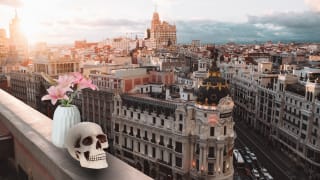Unpicking the DNA of your destination
Todd Babiak is CEO of Brand Tasmania: the place branding authority for the Australian state of Tasmania. In an interview with Claire Farrow, editorial contributor at City Nation Place, Todd shares insights into the approach he is taking which, by taking a bottom up approach that taps into Tasmanians’ source of pride, is enabling him to roll out a sustainable strategy for 2020 and beyond.
Inside out
The story of how Todd came to be CEO of Brand Tasmania is in itself quite revealing.
Todd co-founded the consultancy Story Engine in 2011, with a place branding division called Places are People. One of his clients was Hobart, the Capital City of Tasmania.
As part of his work for Hobart, Todd spent five weeks in Tasmania interviewing people and putting together their strategy. When he handed the strategy over, he thought his job was done, but in fact it had only just begun. He returned eight months later to do two hundred more interviews, for the state brand. Then, when the brand story was ready, Tourism Tasmania was interested in the expression of Tasmanian culture.
He was invited to apply for the post of Brand Tasmania CEO.
Having conducted 100s of interviews with locals he could see that people in Tasmania have a history of hardship and overcoming obstacles. They're determined and passionate. They have to focus on quality, not quantity, on better instead of more, because in a globalised world it's difficult for an island to compete on price. Yet they're charmingly humble in a boastful world. Being Tasmanian is the quiet pursuit of the extraordinary. He realised that the timing was ideal and that Tasmania would be a perfect place for his family to live the next chapter of their lives. He applied and was offered a five-year contract.
The move has opened his eyes in many ways. As a consultant, working on the outside of government agencies, Todd sometimes couldn’t understand why the strategies he’d designed weren’t implemented as he had envisioned. Now that he’s on the inside, he can see how difficult it is.
A benefit of being an outsider is that he is not only one of Tasmania’s biggest place brand, he is also representative of their international audience.
He counters questions about how a foreigner can be CEO of Brand Tasmania by explaining that he came and listened to what locals told him was Tasmania at its best. He is now perfectly placed to help Tasmanians tell their story to the world.
Discovering the DNA of your place brand
Todd believes firmly that in order to get a place brand strategy right you first have to understand its culture, its DNA; what makes a place special for the people who live there. The goal is to build the brand from the inside out. Once you understand why people live in a place, why they stay, the source of their unique pride, you can then present it to the world.
This often feels like mission impossible but it’s ultimately what makes the work rewarding. Here are Todd’s top tips for unpicking a place’s DNA:
- Don’t take a survey approach as this doesn’t allow you to warm people up in conversation and to probe. Instead conduct in depth interviews with a cross section of people. Todd interviewed 440 citizens including: indigenous Tasmanians; those that had been resident for six or seven years; and “blow ins” – the newer arrivals.
- In your conversations, listen carefully to what makes the place special for people. What makes it different? What would break their hearts if they left? Over the course of the interview period, you start to see stories and patterns emerging. You can then start to test these messages.
- Don’t rely on focus groups – they never get beyond the superficial
- Once you have understood the essence of a place’s DNA and know its story, you can clearly see see how to inspire and encourage the local population and how to attract tourists, talent, investment and students to the place. What can they find only in Tasmania?
Unity vs randomness
In the past, Tasmanians felt like second class Australians; the media reinforced images of isolation, poverty, even backwardness. But now there is a new feeling in Tasmania. Tasmanians have responded to adversity and hardship by working harder. The economy is not based on commodities, but on premium products and services. The state will derive 100% of its energy from renewable sources in two years, which puts it ahead of the game.
In Todd’s eyes his job is to harness this energy and bring unity to the state. You could say he is in the unity business. But unity is hard. Randomness is easy. And it’s a fine line to tread.
He wants to bring people together and give them a sense of ownership of their place brand. On the other hand, he doesn’t want to squash ideas or be the brand police.
Having said that, he has found little resistance to his approach in Tasmania. He believes this is because the research was based on listening. His team only tells the story they heard from Tasmanians.
The first phase of his work is to operate as a client service - to help the people of Tasmania to build and tell their stories with a sense of ownership and pride. To facilitate this, he is running workshops and because he realised that people don’t have time to tell their own stories, he has built a website for Tasmanians to build their own story and to use the Tasmanian brand.
The goal is to turn ideas into action and spark something really special; to bring the Tasmania brand to life and achieve unity (and sustainable economic development) through story and action.
Delivering sustainable economic development
Two innovative approaches that Todd is taking to ensure he delivers on this goal are:
- The Youth Enterprise initiative. Todd wants to ensure every student understands creative entrepreneurship, how to build a team and how to launch something, whether that’s a business or a social venture. Preparing for a "boutique economy" can begin in the early years and extend until graduation from the University of Tasmanian and into careers.
- Whilst promoting Tasmania through its narrative, he is also planning to protect provenance with technology (using blockchain) that protects products from counterfeiting. This will be part of the next phase of Brand Tasmania’s digital strategy; telling Tasmania’s story to Tasmanian Communities and communities around the world
Todd also recognises that, with 95% of the business community comprising small businesses, it is essential that he brings more value to everything Tasmanian and that Tasmania is seen as a premium brand.
With a team of just five people, and limited public money to spend, this means Brand Tasmania has to make creative use of resources and money. Cooperating with many people across other departments is key, along with private sector partners. Doing something that’s "just good enough" is never an option.It's un-Tasmanian.
Over the next four years Todd and his team will work with Tasmanian businesses and communities to build the Tasmanian Energy Brand, along with youth enterprise work and the "digital showcase" - partnering with overseas trade, inbound investment, tourism and universities, as well as Tasmania’s citizens.
Place branding 2020 vision
Todd’s vision for place branding is that those involved in the discipline understand that it’s not about quick fixes or media buying approaches – then walking away. It has to be a bottom up process. First you need to understand a city, state, province or nation’s source of pride - it's unifying cultural expression, its story.
Without doing this part you will end up with something that will be replaced in a couple of years. That is the real expense. It’s crucial to have a sense of who the place is in order to develop the look and feel.
With firm foundations laid you then have to look around the world and do something with a 5, 10, 15 even 20 year view – just as a property developer might with its investments. But it doesn’t have to be expensive. Do it in stages.
The temptation (even though we know it’s wrong) is to go immediately to the logo. Todd stresses that place branding has to be about tangible action rather than a logo. This means that when talking to stakeholders sometimes you have to avoid using the word “brand” as many equate “brand” with “logo”. The key is to get beyond this so that people understand what the opportunity is.
Wrapping up Todd reminds me that: “Design has never been more beautiful. Video has never been cheaper to make. But until you know your place’s DNA, it will feel pretty, but random, like this could have happened anywhere”.
Related Reading
What gets in the way of powerful place branding | Todd Babiak
Lithuania's DNA | Award winning case study
Reimagining Mississauga's place brand identity | David Ferreira









